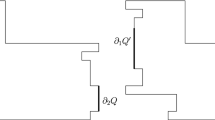Abstract
Directed percolation (DP) is the most widely observed transition to the absorbing state in the nonequilibrium systems. For all continuous transitions with positive one-component order parameter, short-range processes in space and time, and without additional symmetries or quenched disorder, DP is the expected universality class. We study the robustness of the DP universality class under the relaxation of these conditions. (a) We consider two types of particles, A and B such that A sites recover in one time-step with probability \(1-p\), while type B definitely recovers in \(\tau \) time-steps. (b) A fraction of sites are coupled to nearest neighbors and the rest are coupled to the next-nearest neighbor. (c) The sites infected in previous \(t_m\) time-steps are infected with lower probability \(p_1\) and the rest are infected with probability p. (d) We examine the effect of global external forcing on the contact process. (e) We study the relevance of quenched disorder in coupled map lattice. (f) We study connections to a common manifold in a 2D contact process. These infinite long-range connections lead to the DP universality class in 1D. In all these cases except power-law forcing with a small decay exponent and large delay in model (a), the order-parameter decay exponent stays in the DP class. Thus, the DP universality class is robust under the relaxation of many of its prerequisites.
Graphic abstract



















Similar content being viewed by others
Data Availability Statement
This manuscript has no associated data or the data will not be deposited. [Author’s comment: All data that support the plots within the paper and other findings of the study are available from the first author upon reasonable request.]
References
M. Henkel, H. Hinrichsen, S. Lübeck, M. Pleimling. Non-equilibrium phase transitions, vol 1. Springer (2008)
H-K. Janssen. On the nonequilibrium phase transition in reaction–diffusion systems with an absorbing stationary state. Z. Phys. B Condens. Matter 42(2), 151 (1981)
P. Grassberger. On phase transitions in schlögl’s second model. In: Nonlinear Phenomena in Chemical Dynamics, p 262. Springer (1981)
I. Jensen, Critical behavior of the pair contact process. Phys. Rev. Lett 70(10), 1465 (1993)
S.S. Pakhare, P.M. Gade, Novel transition to fully absorbing state without long-range spatial order in directed percolation class. Commun. Nonlinear Sci. Numer. Simul. 85, 105247 (2020)
H. Hinrichsen, M. Howard, A model for anomalous directed percolation. Eur. Phys. J. B 7(4), 635–643 (1999)
A.Y. Tretyakov, N. Inui, N. Konno, Phase transition for the one-sided contact process. J. Phys. Soc. 66(12), 3764–3769 (1997)
D. Mollison, Spatial contact models for ecological and epidemic spread. J. R. Stat. Soc. Ser. B Stat. Methodol. 39(3), 283 (1977)
E.V. Albano, Critical behaviour of a forest fire model with immune trees. J. Phys. A Math. Theor. 27(23), L881 (1994)
S. Havlin, D. Ben-Avraham, Diffusion in disordered media. Adv. Phys. 36(6), 695 (1987)
P. Rupp, R. Richter, I. Rehberg, Critical exponents of directed percolation measured in spatiotemporal intermittency. Phys. Rev. E 67(3), 036209 (2003)
K.A. Takeuchi, M. Kuroda, H. Chaté, M. Sano, Directed percolation criticality in turbulent liquid crystals. Phys. Rev. Lett. 99(23), 234503 (2007)
T. Vojta, Rare region effects at classical, quantum and nonequilibrium phase transitions. J. Phys. Math. Gen. 39(22), R143 (2006)
A.B. Harris, Effect of random defects on the critical behaviour of ising models. J. Phys. C Sol. State Phys. 7(9), 1671 (1974)
J. Hooyberghs, F. Iglói, C. Vanderzande, Absorbing state phase transitions with quenched disorder. Phys. Rev. E 69(6), 066140 (2004)
T. Vojta, M. Dickison, Critical behavior and griffiths effects in the disordered contact process. Phys. Rev. E 72(3), 036126 (2005)
O. Motrunich, S.-C. Mau, D.A. Huse, D.S. Fisher. Infinite-randomness quantum ising critical fixed points. Phys. Rev. B 61(2), 1160 (2000)
R. B Griffiths, Nonanalytic behavior above the critical point in a random ising ferromagnet. Phys. Rev. Lett. 23(1), 17 (1969)
P.D. Bhoyar, P.M. Gade, Emergence of logarithmic-periodic oscillations in contact process with topological disorder. Phys. Rev. E 103(2), 022115 (2021)
E. Domany, W. Kinzel, Equivalence of cellular automata to ising models and directed percolation. Phys. Rev. Lett. 53(4), 311 (1984)
R.J. Smith, S.M. Blower, Could disease-modifying hiv vaccines cause population-level perversity? Lancet Infect. Dis. 4(10), 636–639 (2004)
D. Weycker, J. Edelsberg, M. E. Halloran, I.M. Longini Jr, A. Nizam, V. Ciuryla, and G. Oster. Population-wide benefits of routine vaccination of children against influenza. Vaccine 23(10), 1284–1293 (2005)
S. Altizer, A. Dobson, P. Hosseini, P. Hudson, M. Pascual, P. Rohani, Seasonality and the dynamics of infectious diseases. Ecol. Lett. 9(4), 467–484 (2006)
Y. Pomeau, Front motion, metastability and subcritical bifurcations in hydrodynamics. Phys. D 23(1–3), 3–11 (1986)
H. Hinrichsen, On possible experimental realizations of directed percolation. Braz. J. Phys. 30, 69–82 (2000)
Z. Jabeen, N. Gupte, Dynamic characterizers of spatiotemporal intermittency. Phys. Rev. E 72(1), 016202 (2005)
P. M. Gade and C.-K. Hu. Scaling and universality in transition to synchronous chaos with local-global interactions. Phys. Rev. E 73, 036212 (2006)
T.M. Janaki, S. Sinha, N. Gupte, Evidence for directed percolation universality at the onset of spatiotemporal intermittency in coupled circle maps. Phys. Rev. E 67(5), 056218 (2003)
Acknowledgements
PMG thank DST-SERB (CRG/2020/003993) for financial assistance. MCW thank Council of Scientific and Industrial Research (C.S.I.R.),SRF(09/128(0097)/2019-EMR-I) for financial assistance.
Author information
Authors and Affiliations
Contributions
PDB, MCW, and PMG contributed to conceptualization, simulations, visualization, and drafting. SB carried out part of simulations in Sect. 2.1.
Corresponding author
Rights and permissions
About this article
Cite this article
Bhoyar, P.D., Warambhe, M.C., Belkhude, S. et al. Robustness of directed percolation under relaxation of prerequisites: role of quenched disorder and memory. Eur. Phys. J. B 95, 64 (2022). https://doi.org/10.1140/epjb/s10051-022-00326-9
Received:
Accepted:
Published:
DOI: https://doi.org/10.1140/epjb/s10051-022-00326-9




